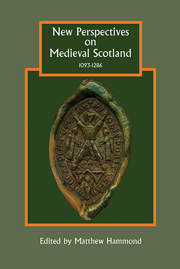Book contents
- Frontmatter
- Contents
- List of illustrations and tables
- List of contributors
- Acknowledgements
- Abbreviations
- Maps
- 1 Introduction: The paradox of medieval Scotland, 1093–1286
- 2 The Scottish ‘political community’ in the reign of Alexander II (1214–49)
- 3 Homo ligius and unfreedom in medieval Scotland
- 4 Scottish royal government in the thirteenth century from an English perspective
- 5 Neighbours, the neighbourhood, and the visnet in Scotland, 1125–1300
- 6 Cistercian identities in twelfth- and thirteenth-century Scotland: the case of Melrose Abbey
- 7 The language of objects: material culture in medieval Scotland
- 8 Structuring that which cannot be structured: a role for formal models in representing aspects of medieval Scotland
- Bibliography
- Index
- STUDIES IN CELTIC HISTORY
5 - Neighbours, the neighbourhood, and the visnet in Scotland, 1125–1300
Published online by Cambridge University Press: 05 August 2013
- Frontmatter
- Contents
- List of illustrations and tables
- List of contributors
- Acknowledgements
- Abbreviations
- Maps
- 1 Introduction: The paradox of medieval Scotland, 1093–1286
- 2 The Scottish ‘political community’ in the reign of Alexander II (1214–49)
- 3 Homo ligius and unfreedom in medieval Scotland
- 4 Scottish royal government in the thirteenth century from an English perspective
- 5 Neighbours, the neighbourhood, and the visnet in Scotland, 1125–1300
- 6 Cistercian identities in twelfth- and thirteenth-century Scotland: the case of Melrose Abbey
- 7 The language of objects: material culture in medieval Scotland
- 8 Structuring that which cannot be structured: a role for formal models in representing aspects of medieval Scotland
- Bibliography
- Index
- STUDIES IN CELTIC HISTORY
Summary
In the spring of 1266 Alexander Stewart lord of Dundonald set his seal to a charter that extended to Melrose Abbey a series of privileges designed to enhance the already broad authority that the abbot and monks exercised over their Ayrshire-based estates. Among these was exemption from the obligation to make suit of Stewart's baronial court and the opportunity henceforth to reserve to themselves the profits of justice arising from the trial of miscreants resident on abbey lands. The monks, however, pressed their benefactor for more still, and secured from Stewart measures that would in future facilitate the trial of persons suspected of theft and other serious offences within their Ayrshire lands. More specifically, the charter provided for the summoning of a jury – here described as a uisnetum – comprised of tenants from both the Stewart lands and those of the monks, who were charged with sole responsibility for determining the guilt or innocence of anyone so taken. In an effort to lend weight to the charter the beneficiaries sought and obtained confirmation of its terms from King Alexander III. The scribe who recorded the agreement chose the specific term uisnetum over several others that he might have used and he did so not merely out of convenience, but rather to signal his grasp of the technical language of contemporary law.
- Type
- Chapter
- Information
- New Perspectives on Medieval Scotland, 1093-1286 , pp. 161 - 174Publisher: Boydell & BrewerPrint publication year: 2013



